Food Science Experiment: Carob Bean Gum vs. Xanthan Gum
I like making ice cream. If you like, check out my recipes or take a look at my notes about making ice cream. I want to talk about a category of ingredient that’s never the star of the show, but can be found in a huge part of industrial food products and is crucial in ice cream recipes: thickening agents. There are a lot of different ones with varying properties. Their purpose in ice cream is to improve texture and slow down melting.
What Happened So Far
So far, I’ve been using a combination of one half xanthan gum and one half carob bean gum (also known as locust bean gum) in my recipes. The amount was mostly just eyeballed, around 1 to 2 g per portion, depending on how viscous the other ingredients were.
I chose those two mostly after looking around a bit online and looking at what other people were using. For example, carob bean gum is used a lot in industrial products. James Hoffmann used it together with lambda carrageenan in his coffee ice cream recipe, which is actually what got me interested in making ice cream in the first place. Xanthan on the other hand isn’t seen as often, but the German Wikipedia page on it says that it synergizes well with carob bean gum and that it is used in ice cream.
There are thickening agents that work just by mixing them into a liquid, but also ones that require heating before they become solid. For example pectin, the component that makes jam solid, only becomes solid when heating the jam mixture. However, for my ice cream, I wanted thickeners that don’t need heating. Carob bean gum and xanthan satisfy that criterion.
Considering that I didn’t really find a lot of non-vague information of the properties of different thickening agents, that they’re easy to source online and that they don’t seem to have any health concerns tied to them1, I just went with those for my recipes.
However, I wanted to investigate the properties of these ingredients for a while now in order to gain a better understanding of what they do in recipes. Also, I noticed that my ice creams tended to take a somewhat gelatinous form when melting, a little bit like jello? Not very appetizing and I suspected the thickening agents.
Experiment
I prepared 5 mixtures for this experiment:
- 1 g carob bean gum + 180 g water
- 1 g xanthan gum + 180 g water
- 0.5 g carob bean gum + 0.5 g xanthan + 180 g water
- 1 g carob bean gum + 40 g water
- 0.5 g xanthan gum + 80 g water

Ian: Hey, shouldn’t you be writing your thesis?
cough I don’t know what you’re talking about. Anyway, as I was saying, I prepared these mixtures by first weighing the gum, then adding the water and whisking it with a handheld milk foamer. I documented the texture, the look and the taste.
I also recorded a ~10 minutes long video showing the results and uploaded it to YouTube. If you want to see what the mixtures look and behave like, take a look at it. I also added some stills from the video here, but it’s much more clear to understand the consistency if viewing it in motion. Also: sorry for the video and image quality.
Look & Feel
A general observation is that carob bean gum seemed to take some more time to solidify when mixing in compared to xanthan, although I can’t quantify that.
1 g carob bean gum + 180 g water
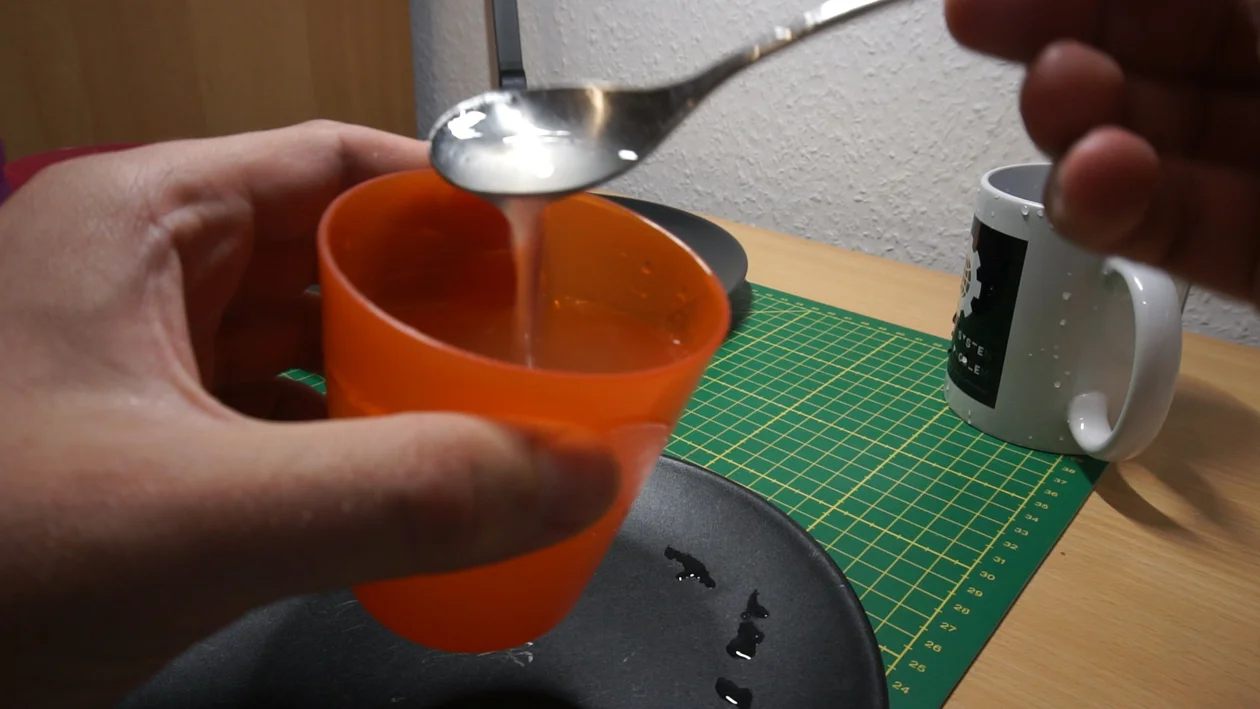
- noticeably viscous, but still very liquid
- nothing special otherwise
- white, quite opaque
1 g xanthan gum + 180 g water
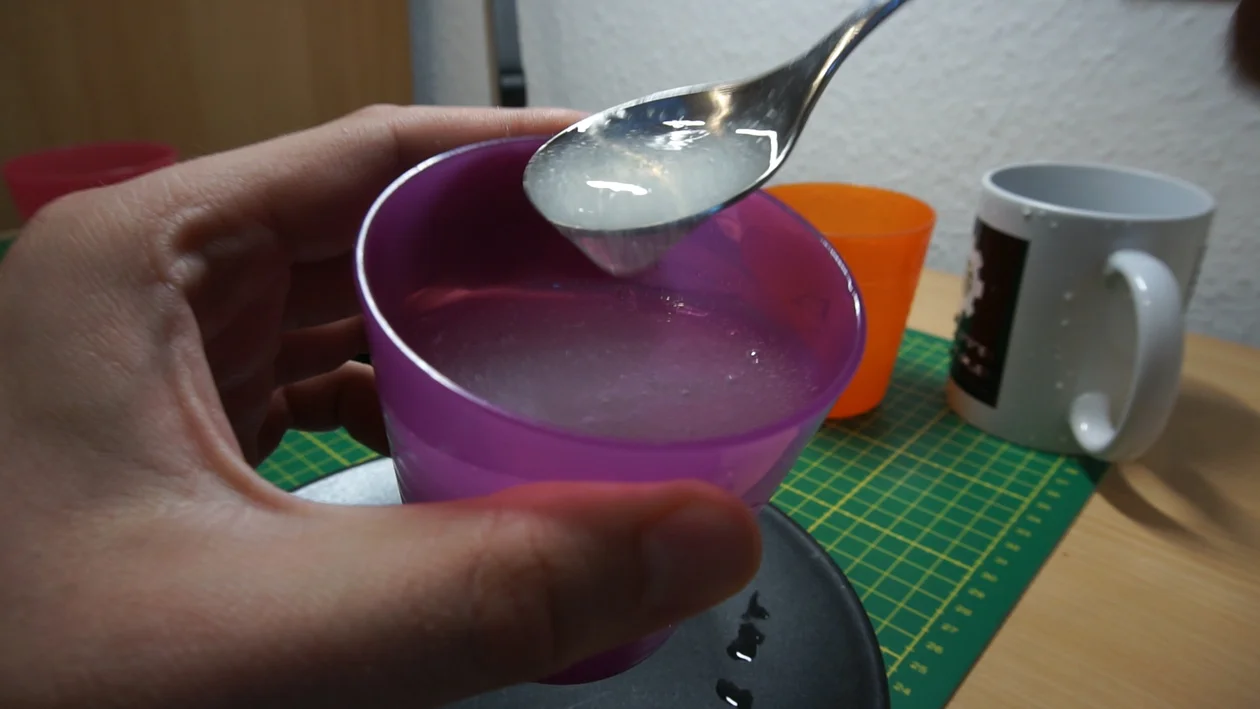
- significantly more viscous than previous sample
- so xanthan seems to be more potent
- slightly gelatinous, slides from a spoon in pulsed pieces
- more opaque and white than previous sample
- holds a lot of quite large bubbles, even hours after whisking
- again, gel-like: it isn’t just a viscous liquid, it has some solidity
- a bit slimy as well
0.5 g carob bean gum + 0.5 g xanthan + 180 g water
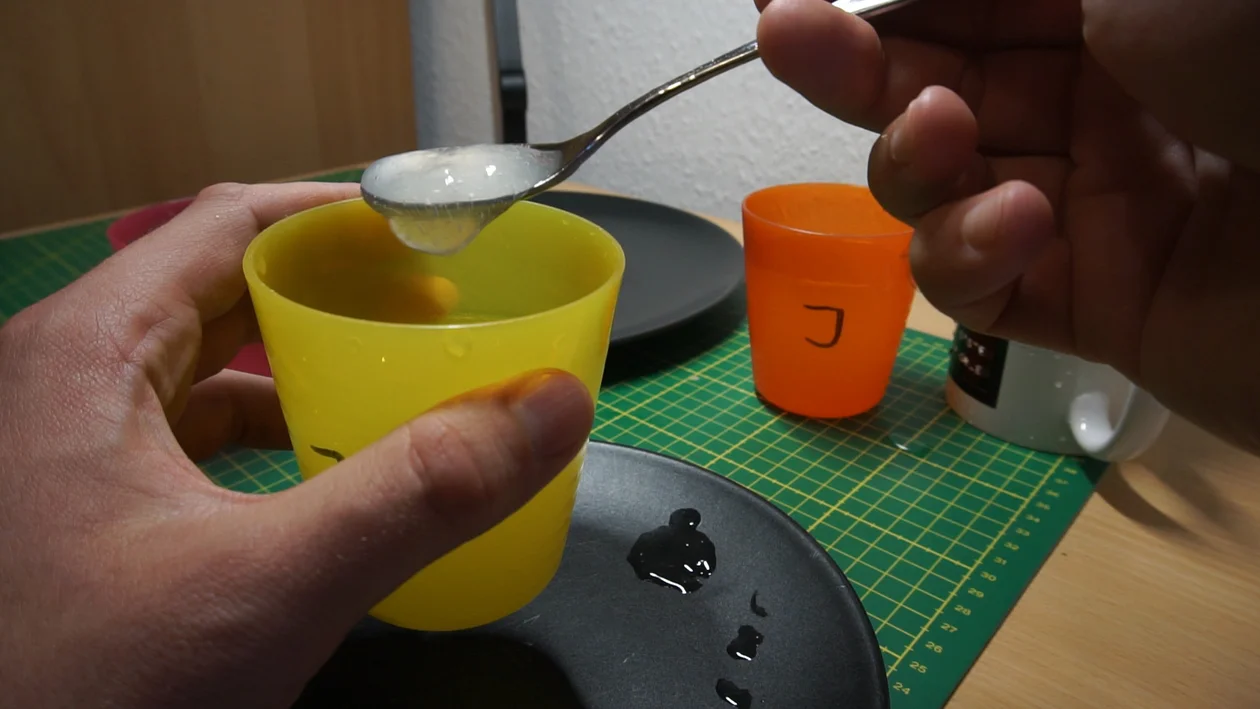
- similar in look to pure xanthan
- feels similarly viscous when stirring, but is much more gelatinous
- especially after not stirring it for a while, it’s very much like jello
- if letting it slide of a spoon, it comes down in pieces
- in the video I had recently stirred it, it became much more solid again later
- this makes sense considering German Wikipedia on Xanthan claims that carob bean gum + xanthan gum forms a thixotropic gel
- less air bubbles than pure xanthan
- this mixture had some powder clumps left I wasn’t able to stir in properly due to the high solidity
- in conclusion, it’s similar in viscosity to pure xanthan, even though half of it has been replaced with the less potent carob bean gum, and it’s much more solid / gelatinous
1 g carob bean gum + 40 g water
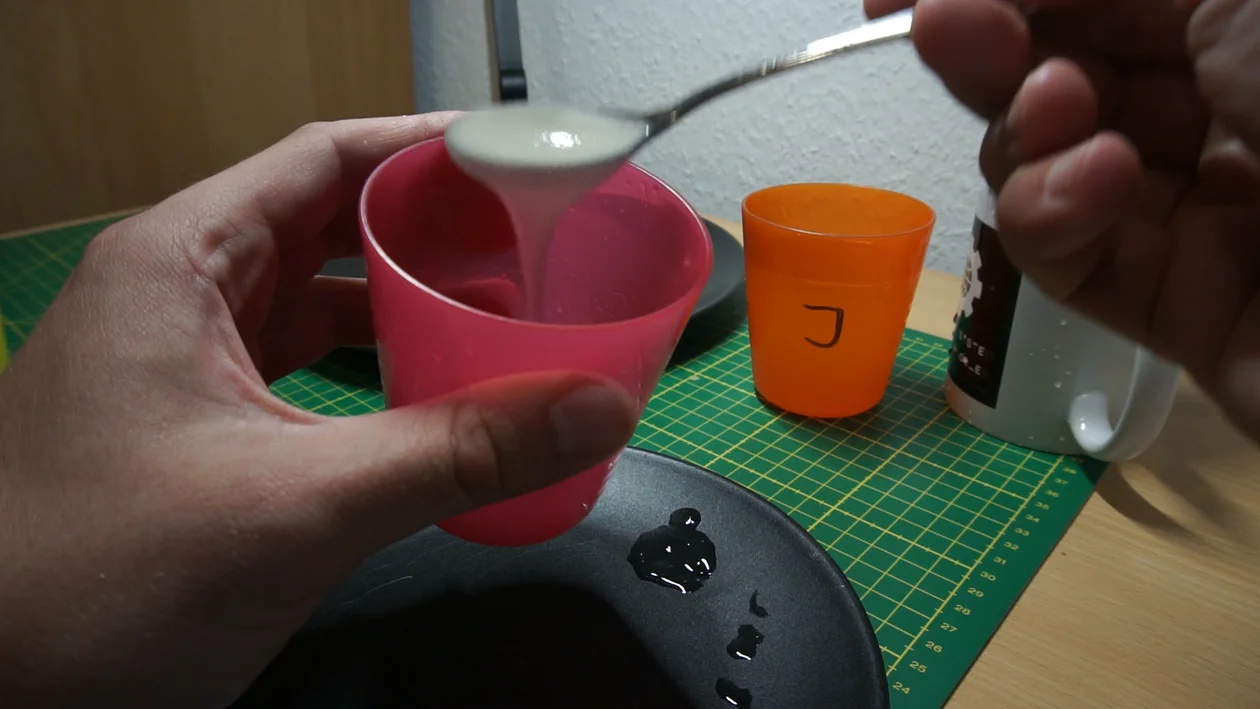
- As my previous pure carob bean gum was still very liquid, I wanted to try a higher concentration
- In this concentration it’s very viscous, more viscous than the 1:180 xanthan mixture
- but other than xanthan, it’s not gelatinous at all
- the consistency is more like sugar icing before hardening
- smooth, almost creamy, a little slimy
- it’s also very opaque, and has a yellowish white color
0.5 g xanthan gum + 80 g water
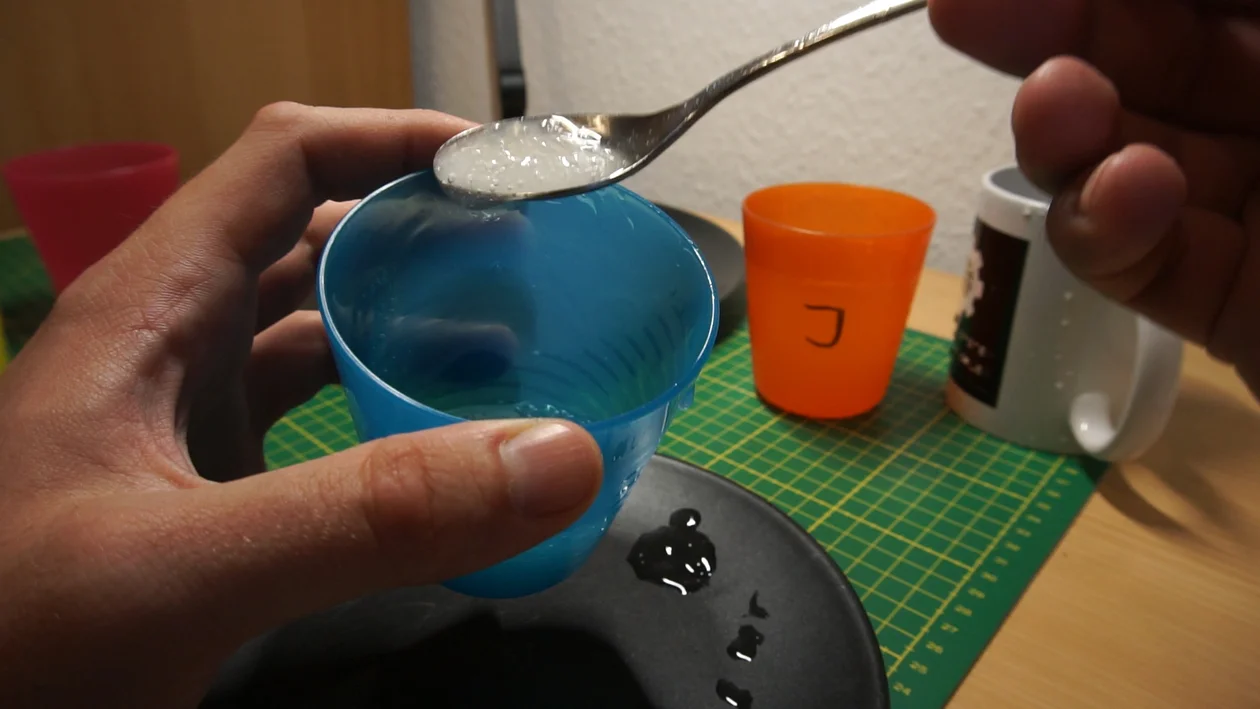
- I also wanted to try out a more concentrated xanthan mixture
- mostly similar in viscosity to the previous pure xanthan mixture
- (it’s only a little bit more concentrated)
- however, it is noticeably more gelatinous
Taste
I’d say the carob bean gum has a flour-like taste with a tiny bit of sweetness. Quite subtle, I’d say, nothing funky. The xanthan also exhibits a flour-like taste. A bit more sweetness than the carob bean gum, especially in the aftertaste. It also has a slight, but noticeable additional taste that’s hard to describe. Plastic-y? Even oil-y? All in all a little less subtle, but not bad.
Conclusion
I’d summarize the differences between the two ingredients as: carob bean gum creates a smooth and viscous liquid. Xanthan is much more potent, you need less to create the same viscosity, and it creates a gelatinous consistency. If used together they are more potent and create more solid gels rather than just viscous liquids.
The consequence for my ice cream recipes is pretty clear: going forward, I will just be using pure carob bean gum as thickening agent. The jello-like texture of my melting ice cream I mentioned in the beginning seems to be caused of using xanthan and carob bean gum together. Also, carob bean gum has a more subtle taste. I’ll also go over the amounts of thickeners I use, now that I have more of a feeling of what consistency what amount of carob bean gum yields.
The gelatinous texture and ability to hold air bubbles of the xanthan and half-half mixtures is still very interesting. I might look into using that in other recipes, but it’s just not what I want in ice cream. In the future, I’d like to try out some other thickening agents commonly used in ice cream as well, for example tara gum or guar gum. But for now, I’m happy with carob bean gum.
Note that a significant portion of “health concerns” surrounding food additives seems to be unsubstantiated fearmongering. I recommend doing some research into what’s fact and what’s fiction before actually ruling an ingredient out.↩︎
Thank you for reading!
If you like, follow me on the ⁂ Fediverse / Mastodon! I'm @eisfunke@inductive.space.
If you have any comments, feedback or questions about this post, or if you just want to say hi, you can ping me there or reply to the accompanying Mastodon post.